Sodom and Gomorrah
and the Dead Sea
by Jeffrey J. Harrison
The maps in many Bibles make Israel look like a pretty ordinary place. But nothing could be further from the truth. From the flat, barren deserts in the south to the soaring, snow-capped Mt. Hermon in the north, from the sunny Mediterranean coastline on the west to the plunging chasm of the Rift Valley on the east, Israel is a land of dramatic contrasts. The Rift Valley descends more than a thousand feet below sea level (1300 ft, 400 m), the deepest point on the surface of the earth above water.* That’s the reason for the name of the Jordan River, which flows through part of this valley: it comes from a root that means to go down
(yarad in Hebrew)—way down.
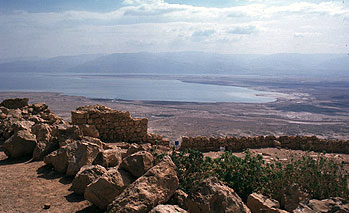
* The Rift Valley ( the Aravah in Biblical Hebrew) extends the whole length of Israel on the east side. Today, the northern section, where the Jordan River flows, is known as the Jordan Valley; the dry southern section is known (in Modern Hebrew) as the Aravah.
This huge canyon was created by earthquakes: lots of them. Two huge pieces of the earth’s crust rub up against each other here producing measurable earthquakes almost every day or two. A handful of these can be felt each year without instruments. Every few years there’s one big enough to do some damage. And every few hundred years, there’s one big enough to level every building in the area—like that in the time of King Uzziah mentioned in Amos 1:1 and Zech. 14:5.
At the deepest point of the Rift Valley is the Dead Sea. Its waters are thirty percent salt, nine times the salinity of the ocean. No fish can live in its waters, and nothing can grow along its shore.* The desert continues right up to the edge of the water.
* With the exception of a few places where fresh water springs run down to the water, supporting a few species that can tolerate the salty soil, as at Ein Feshka near Qumran.
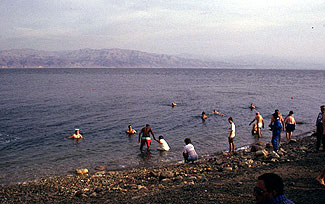
This is an unstable area. There is underground heat, as can be seen in the hot springs on both sides of the Dead Sea.* There are also petroleum products, as can be seen in the oil slicks that occur regularly on the surface of the water. Big chunks of tar or asphalt occasionally come floating to the surface. This gave the Dead Sea its Roman name: Lake Asphaltitis (the Lake of Asphalt). In the time of the New Testament, Josephus reported that there were pieces of tar floating in the water the size and shape of headless bulls
(Wars 4.8.4 § 479). These were collected by ships and sold. The tar was used for sealing the seams of ships and in medicines.** Hundreds of years before Abraham, Dead Sea tar was already being traded to Egypt for use in making mummies.
* As at Callirhoe, on the eastern side, where King Herod sought relief from the horrible illness that brought his death (Josephus, Antiquities 17.6.5 § 171).
** The use of tar to caulk boats dates back to Noah’s ark (Gen. 6:14). The Jesus boat
discovered at the Sea of Galilee from the time of Jesus was also sealed with tar.
In the 5th century AD, a Christian monk named Sabbas went floating on one of these islands of tar for forty days and nights during a time of fasting. On his way back home, he fell into a burning tar pit and was terribly burned.* We don’t see any more of these tar pits today near the Dead Sea, but they were there in the time of Abraham. The Bible says the area was full of tar pits
(Gen. 14:10).**
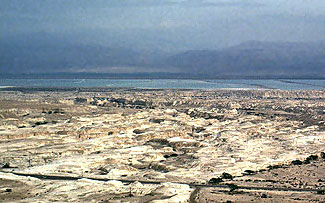
* The life of Sabbas was written by Cyril of Scythopolis. Sabbas (Sabbas the Sanctified) was an important figure in monastic Christianity in Israel. The monastery founded by him in the desert outside of Bethlehem (Mar Saba) has been continually inhabited from the time of its foundation (5th cent.) until today.
** These pits may later have been covered by the shallow, southern lobe of the Dead Sea (its southernmost 15 miles/25 km), which is known to have formed in the historical past, perhaps as the result of an earthquake. When dry, this area may have been the Valley of Siddim near Sodom and Gomorrah (Gen. 14:3,8,10). Today, this southern section of the Dead Sea has been converted into salt pans that are mined by Israel and Jordan. Including this southern section, the Dead Sea measures 10 miles wide by 43 miles long (17 x 76 km), about five times larger than the Sea of Galilee.
This is not the only change since the time of Abraham. Today, except for the water of the Dead Sea, it’s a dry and barren desert. But in Abraham’s time, it was green and fertile. Genesis says it was like the garden of the LORD,
that is, the Garden of Eden, and like the land of Egypt,
that is, the fertile Nile Valley (Gen. 13:10).* This is what attracted Lot when he separated his flocks from those of his uncle Abraham and moved down into the Rift Valley.
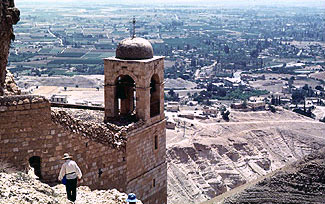
* The area is also described here as mashekeh, often translated well watered,
though it actually means irrigated.
As in the Garden of Eden and the Nile Valley, the land here was made green through artificial irrigation. Rain water flowing down through desert wadis (dry river beds) or emerging from springs was trapped and put to use in growing crops, as is still done today in Jericho.
Archaeology confirms that in the time just before Abraham, the settlement pattern of the land was also quite different than it is today.* The hill country up above the Rift Valley on the east and west, where almost all the population lives today, was sparsely settled, leaving lots of open space for Abraham to pasture his flocks. Most of the large population centers were in the lowlands. This includes the Rift Valley, where five large cities have been discovered by archeologists dating to this period.** To give you an idea of the size of these cities: the first burial ground discovered (at Bab edh-Dhra) held up to 500,000 burials! That’s one of the largest cemeteries yet found in the entire ancient Middle East. Two others were soon discovered with nearly equal numbers of burials (at Feifa and Khanazir). That’s a total of up to 1.5 million burials! There must have been a lot of people living here at the time. This also confirms that the land was more fertile in the past. Otherwise it’s hard to imagine how so many people could have survived here. These five cities match the five cities of the plain
mentioned in Genesis: Sodom, Gomorrah, Admah, Zeboiim, and Bela (Gen. 14:2).***

1. Bab edh-Dhra (Sodom), 2. Numeira (Gomorrah), 3. Safi (Zoar/Bela), 4. Feifa (Admah), 5. Khanazir (Zeboiim)
* In the Early Bronze Age (EB III/IV).
** Known by the Arabic names Bab edh-Dhra, Numeira, Safi, Feifa, and Khanazir.
*** Many critical scholars are hesitant to associate the Bab edh-Dhra excavations with Genesis because they prefer to date Abraham several hundred years later, if they believe he was a historical figure at all. But the Bible puts Abraham in Israel by 2091 BC, the same general time period in which Bab edh-Dhra and its neighboring cities were destroyed.
Abraham first became involved with the cities of the plain after Lot moved down to Sodom (Gen. 14:2). Four kings from the area of modern Iraq mounted a raid in which Lot and many others were taken captive. When Abraham heard of it, he rallied a force of three hundred and eighteen men from his own household—servants and the sons of servants—to pursue them. In a daring night raid, Abraham surprised the enemy and set all the captives free (Gen. 14:15-16).
Perhaps because Abraham fought so valiantly on behalf of these people, or perhaps because of Lot’s residence there, when later God was planning to destroy these cities, he first stopped by to notify Abraham of his plans. Abraham’s tent, at the time, was at Mamre, near Hebron up in the hill country of central Israel. From here, there is a wide-open view east across the desert (Gen. 18:1). If you walk just a short distance further east, a spectacular view opens up looking down into the Rift Valley.
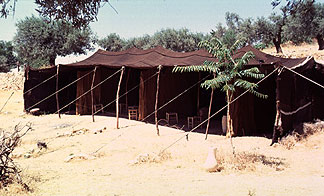
Abraham’s tent, like the Bedouin tents of today, would be set up with its long sides facing east and west. In warm weather, the whole eastern side of the tent is opened to catch the rays of the sun in the morning, and to keep it cool in the hot afternoon. As Abraham sat there in the shade of the tent, looking out the open east side—in the direction of Sodom—he saw three men standing in the hot sunlight (Gen. 18:2). This was odd. The heat of the day wasn’t the usual time to travel. Perhaps this awakened Abraham’s compassion for them and contributed to his especially generous hospitality. But then again, hospitality is an important part of nomadic life in the desert even today.
In spite of the fact that there were three men, Abraham addresses himself to only one of them (my lord,
adonai in Hebrew; Gen. 18:3). One of the men, by his appearance or manner, was clearly in authority over the other two. Abraham invited them to rest a while, offering a little bread and water (Gen. 18:4-5). But in the end he prepared a feast: a freshly butchered calf, fresh bread and cheese curds, and milk (Gen. 18:8).
While they were eating, the man that Abraham had first spoken to prophesied that Sarah would have a son (Gen. 18:10). Here the visitor is first identified as the Lord (Yhwh in Hebrew): God himself appearing to Abraham as a man (Gen. 18:13).* But how can God appear as a man, when the Bible clearly teaches that no man can see God and live (Exo. 33:20)? This is an appearance of what elsewhere the Bible calls the Angel of the Lord, who is Yhwh himself. How can a messenger from God be God? That’s the question, isn’t it? And that’s exactly why Christianity teaches not only that God has revealed himself, but that he actually exists, in more than one mode of being.** He exists in heaven as the ruler of the universe, beyond time and space (as the Father), but he has another simultaneous way of existing (the Son), that can come down to earth and speak to us in the appearance of a man.
* Yhwh is the personal name of God, often referred to as the Tetragrammaton (the four letters
). It is spelled without vowels because no one is sure exactly how it was pronounced. Unlike all the other names of God, which are titles or descriptions, this is his proper name, equivalent, for example, to the proper name of his host, Abraham. (For more on this topic, see our index category Yahweh.)
** Or way of existing (hypostasis in Greek). This Greek word, used by the early Church, is more adequate than its Latin equivalent persona, at least in a modern context, because the Latin term (the meaning of which is similar to the English word persona
) is often misleadingly translated person.
This gives people the impression that God is three separate beings, which is incorrect. God is one being with three simultaneous ways of existing.
After they finished their meal, the men began to walk east in the direction of that beautiful view over the Rift Valley, with Abraham walking along to see them off (Gen. 18:16). Here the man who was God revealed to Abraham his plan to destroy the cities of the plain (Gen. 18:20-21). Once again, Abraham tried to help these people, this time by interceding with God: What if there are fifty righteous people in the city? Won’t you spare it because of them (Gen. 18:24)? Yes, God said, he would (Gen. 18:26). But since that didn’t deter God in his plan, Abraham continued to bargain with God: What if there are forty righteous people? or twenty? or even ten? After agreeing to ten, God walked on. The interview was over, but the situation didn't look good for Sodom.
Until this point, the Bible has given no indication of what made Sodom and Gomorrah so wicked. But we soon find out when the two angelic companions of the Angel of the Lord enter Sodom (Gen. 19:1).* Here they meet Lot, sitting in the gate of the city.** Like his uncle Abraham, Lot shows great hospitality to the two visitors, not only inviting them to his home, but even insisting that they stay with him. Here he prepares a feast, just as his uncle had done (Gen. 19:3).
* This verse is where we find out that they are angels (called messengers
in Hebrew): And two of the messengers (angels) came toward Sodom in the evening...
** This tells us that Sodom had city walls, which matches the discoveries of the archeologists, who found city walls at Bab edh-Dhra (Sodom).
But the other residents of the city, far from showing kindly hospitality, gathered around Lot’s house with the intention of getting to know
Lot’s visitors (from the Hebrew root yadah, Gen. 19:5)—but not in a polite, social way; rather a carnal, wicked way.* This was not just a few troublemakers. It was all the men of the city, from one side to the other (Gen. 19:3-4)! Now we know what is so horribly wrong with the city, and why God came to destroy it.
* To know
occasionally functions in Hebrew as a euphemism for sexual relations, in this case for homosexuality.
The situation soon became dangerous, and the angels intervened, striking the men of the city with blindness (Gen. 19:11). They then revealed to Lot their mission to destroy the city (Gen. 19:13). Before dawn the next morning, when he delayed, the two angels grabbed the hands of Lot, his wife, and his daughters and brought them out of the city (Gen. 19:16). The final verb of this verse is interesting: it means literally caused him to alight
(yanichuhu), like a bird. In other words, the angels didn’t walk them out of the city—they flew them out!
This is a prophetic picture of the catching up of the believers when Messiah returns (1 Thess. 4:17). It may also tell us how it will take place: an angel will grab hold of your hand, and up you go (Matt. 24:31)!
From there, Lot and his family had to run, after being warned by the angels not to look back (Gen. 19:17). They had just enough time to reach Zoar by dawn, when the angels unleashed their destruction (Gen. 19:23-24).
The Bible describes the catastrophe in an unusual way: And the Lord [Yhwh] rained on Sodom and on Gomorrah sulfur and fire from the Lord [Yhwh] out of heaven
(Gen. 19:24). In other words, the Lord (Yhwh #1), the one who had been visiting with Abraham, rained fire and sulfur from the Lord (Yhwh #2) in heaven. This is one of several places in the Bible where God is mentioned in more than one mode of existence, both of which are given the same proper name: Yhwh. God, in that mode in which he is able to appear on earth, brought judgment from that other, different mode of his existence in the heavens. This is a foreshadowing of what will happen at the return of Messiah, when the Son will send down a fiery destruction from the Father in heaven.*
* It will be just the same on the day that the Son of Man is revealed
(Luke 17:30).
It’s not hard to imagine how the city was destroyed. In that highly unstable area with all those petroleum products around, all it would take is a big enough gas eruption and a single match (Gen. 19:25).* This is, in fact, the most likely suggestion for what happened: that an earthquake released gas into the air that ignited and exploded. This would also account for the fire and bits of sulfur raining down out of the sky.** People would either have been burned by the fire or choked by the fumes.
* Some have suggested it was a volcanic eruption, but there is no volcano close enough for that.
** Asphalt contains a high percentage of sulfur.
This matches the evidence found in the excavations: An earthquake helped destroy the cities. But there was also abundant evidence of burning, including charred human bones. This burning was found not only in the city, but also in the cemetery, which would not be the case if the fire had been the result of war or accident. There was also evidence of some confusion when the city was destroyed: Some blocked their doorways before trying to escape, others did not. But no one ever came back to open those doorways again. Others were found dead inside the buildings without any evidence of burning.
The only other description in the Bible of what happened is in Genesis 19:28. This is when Abraham went out to the same place where he had stood bargaining with God—with its beautiful view down over the Rift Valley—and saw the whole area putting out thick smoke like the smoke of a furnace.
This matches the thick black smoke of a petroleum fire, like when the oilfields of Kuwait were set alight after the Gulf War.
There’s just one more detail to consider: Lot’s wife (Gen. 19:26). Although most translations say she became a pillar of salt,
the word used here (netziv in Hebrew) refers not to a pillar but to a fortified military post (translated as a garrison
in 1 Sam. 13:3-4). The idea is that because she couldn’t keep herself from looking back, she was stationed—permanently—as a watchman in the salty soil, looking out over that place of desolation.*
* Like the bodies encased in ash in the eruption of Mt. Vesuvius at Pompeii.
What happened to her, Jesus said, is a warning to us all: Remember Lot’s wife
(Luke 17:32). This is mentioned in one of Jesus’ prophecies of his return, in which he describes the catching away of the Church: On that day, let not the one who is on the housetop and whose goods are in the house go down to take them away; and likewise let not the one who is in the field turn back
(Luke 17:31). His message? We must be ready to go at a moment’s notice, ready to leave all our possessions behind. Otherwise, when the time comes, we may be tempted to turn back. Remember Lot’s wife!